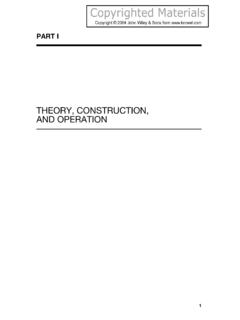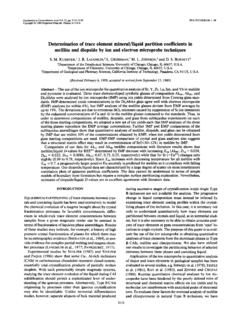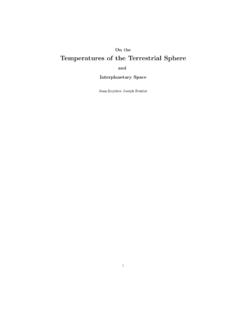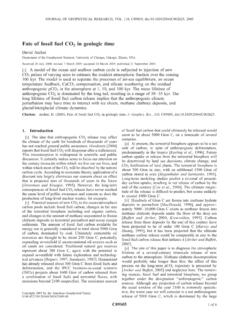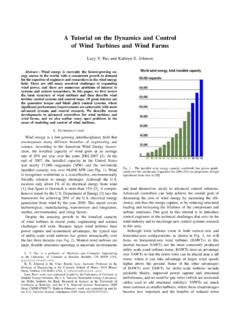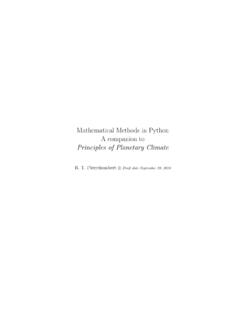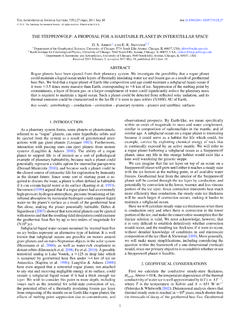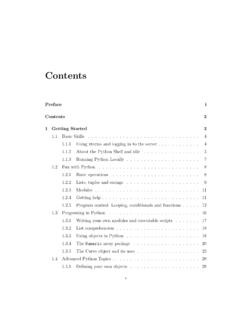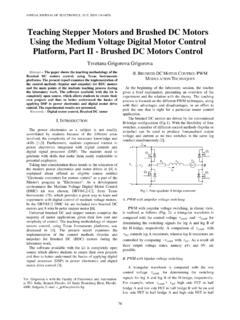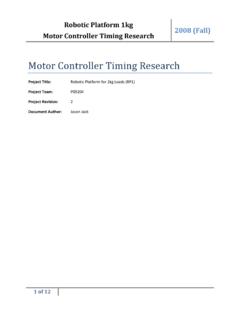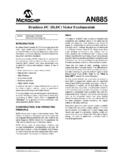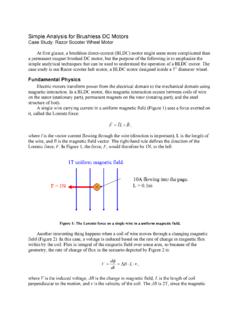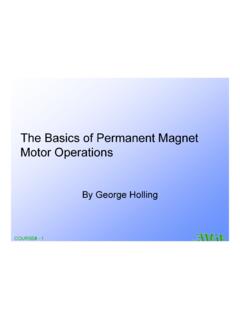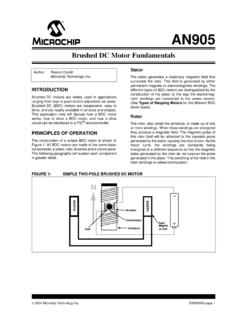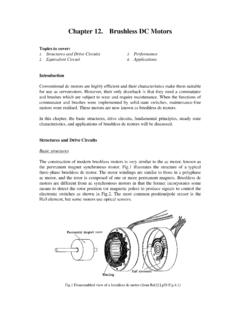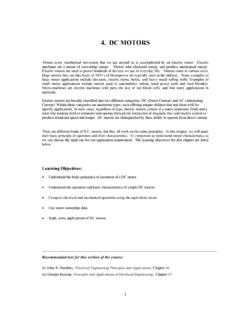Transcription of EJ Moyer, U. Chicago April 29, 2010
1 basics on electric motorsEJ Moyer, U. ChicagoApril 29, 2010 BackgroundElectric motors are essentially inverse generators: a current through coils ofwire causes some mechanical device to rotate. The core principle underlyingmotors is electromagnetic induction. By Ampere s law, the current inducesa magnetic field, which can interact with another magnetic field to producea force, and that force can cause mechanical motion. A motor is basicallya generator run backwards (using current to produce motion rather thanmotion to produce current), and in fact the modern era of practical motorswas initiated by accident when one DC generator was accidentally connectedto another in 1873, producing motion and leading Zenobe Gramme to real-ize that his generators could also be used as motors.
2 The first AC motors(synchronous and then induction) were invented by Tesla in the motors are estimated to now consume over 25% electricityuse (though some estimates are even higher, to up to 50%, and over 20%of total primary energy). While large electric motors can be extremelyefficient at converting electrical energy to kinetic energy ( >90%), thoseefficiencies are only achieved when motors are well-matched to their efficiencies in normal usage practice in the are substantially sub-optimal (motors are oversized for the loads they drive).
3 Small electric motorsare also inherently less efficient (more like 50%). motor design and, evenmore importantly, motor choice and use practices are an important area ofpotential energy reading is a (very brief) introduction to four most basic types ofelectric motors: brushed DC Brushless DC Synchronous AC Induction(Remember, anything you plug directly into the wall is AC; anything yourun directly off a battery must be DC).Like generators, electric motors consist of a stator and a rotor and thethree ingredients: electric current, magnetic fields, and something basic rule of thumb is that in an AC motor , as in an AC generator usedfor industrial power production, the magnet is on the rotor and the current1flows in the stator.
4 In most DC motors, the magnet is in the stator and thecurrent is flowing in the rotor; hence the need for specifications usually involve several quantities: the voltage (orrange of voltages, for DC motors) that the motor can be run at, the rotorspeed (or range of speeds), the electrical power drawn by the motor (oftengiven in horsepower rather than Watts), and finally, the torque or effectiveturning force of the motor (discussed further below). Modern motors span awide range of all these quantities. In particular motors can span 8 orders ofmagnitude in power consumed.
5 Tiny DC motors of the kind used in toys area few Watts in power; big AC hydro generators that are also run backwardas motors to pump water can be over 100 Megawatts. (For more comparisonof motors in daily life: the motor in a household power tool is often 1/4 hp(<200 W) (though they take much more power when starting up); a ceilingor floor fan is<100 W; the compressor in an air conditioner is>1000 W).Torque is a useful concept when describing forces that produce rotationrather than linear motion - it s a measure of the ability of a device to turnsomething.
6 Everyone has an instinctive idea of the power of a lever: if youtry to move something by prying with lever (think of turning a stubborn boltwith a long wrench), you can exert more turning force with a longer leverthan with a short one. Torque (we ll call itT) is that turning force . Inthis definition and the math that follows, the bold-face means that quantitieshave a direction as well as a (optional)The definition of torque isT=r Fwhereris the lever arm andFis the force, and the cross product means thatyou consider only the component of force that is perpendicular to your leverarm, F Newton s lawF=mathen has an analogous form for this tuining force as.
7 T=I where I is the moment of inertia (a measure of how difficult a body isto rotate) and is the rate of change of angular velocity (d dt, where is2the angular velocity). Note that although torque desribes an ability to pushsomething around, its units are force times distance, or plain(er) English, torque is a measure of how much ability a devicehas to rotate a load. Because the function of a motor is to rotate things,that s the ability you care about. In particular, in motors one often wants toknow the torque-speed curve.
8 How does the rate at which a motor rotatesrelate to its ability to turn a load? Some motor have better turning abilityat high speeds, other at low speeds. Which you choose depends on what jobyou want the motor to do. If the motor torque is too low, it won t be able todo the job. Alternately, as discussed above, if your motor is more powerful(higher torque) than you need for a particular job, it will do the job but willhave unnecessary energy inefficiency. (It will waste energy as heating ratherthan converting it to work).
9 DC motorsBrushed DC motorsThe simplest (and cheapest) dc motor is the brushed dc motor . A brushedDC motor is like the simple loop generators we ve seen in cartoons (or theJensen generator used with the steam engine), only run backwards: themagnet is stationary and the DC-current-carrying coil (or coils), connectedto a shaft, rotates through the fixed magnetic field. Loop generators we veseen use slip rings to make electrical contact between fixed current-carryingwires and the rotor. But remember, in the simple loop generators, steadyrotation in one direction with a slip ring produced alternating current.
10 And amotor is the converse of a generator. So if you drove the slip-ringed generatoras a motor withalternatingcurrent, you could get steady rotation. If drive itwithdirect current, though, the loop would just move to a place where forcewas zero and would stay there. To keep the loop moving and produce rotationin one direction requires not slip rings but some kind of commutator thatessentially switches the diretion of the current, putting it first on one side ofthe loop and then on the other, mimicking alternating current.

